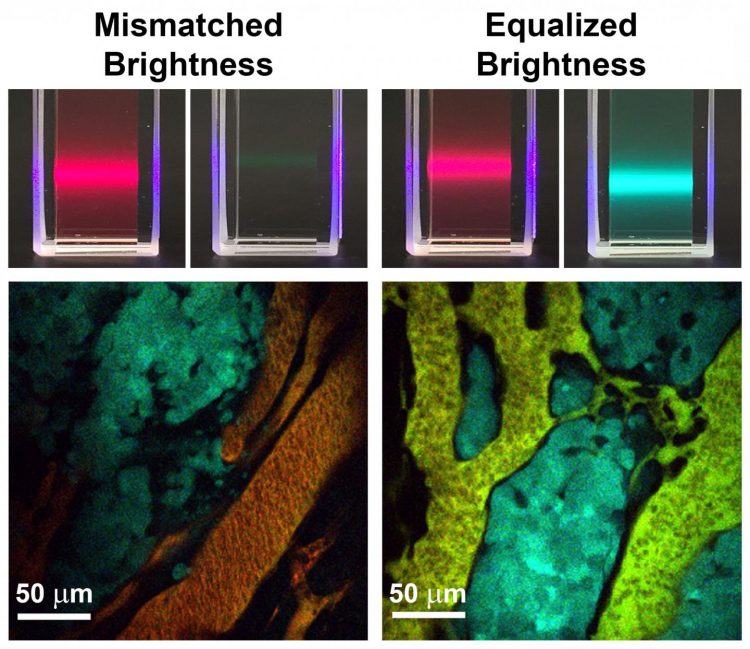Brightness-equalized quantum dots improve biological imaging

Left: Conventional fluorescent materials like quantum dots and dyes have mismatched brightness between different colors. When these materials are administered to a tumor (shown below) to measure molecular concentrations, the signals are dominated by the brighter fluorophores. Right: New brightness-equalized quantum dots that have equal fluorescence brightness for different colors. When these are administered to tumors, the signals are evenly matched, allowing measurement of many molecules at the same time. Credit: University of Illinois
“In this work, we have made two major advances–the ability to precisely control the brightness of light-emitting particles called quantum dots, and the ability to make multiple colors equal in brightness,” explained Andrew M. Smith, an assistant professor of bioengineering at Illinois.
“Previously light emission had an unknown correspondence with molecule number. Now it can be precisely tuned and calibrated to accurately count specific molecules. This will be particularly useful for understanding complex processes in neurons and cancer cells to help us unravel disease mechanisms, and for characterizing cells from diseased tissue of patients.”
“Fluorescent dyes have been used to label molecules in cells and tissues for nearly a century, and have molded our understanding of cellular structures and protein function. But it has always been challenging to extract quantitative information because the amount of light emitted from a single dye is unstable and often unpredictable.
Also the brightness varies drastically between different colors, which complicates the use of multiple dye colors at the same time. These attributes obscure correlations between measured light intensity and concentrations of molecules,” stated Sung Jun Lim, a postdoctoral fellow and first author of the paper, “Brightness-Equalized Quantum Dots,” published this week in Nature Communications.
According to the researchers, these new materials will be especially important for imaging in complex tissues and living organisms where there is a major need for quantitative imaging tools, and can provide a consistent and tunable number of photons per tagged biomolecule.
They are also expected to be used for precise color matching in light-emitting devices and displays, and for photon-on-demand encryption applications. The same principles should be applicable across a wide range of semiconducting materials.
“The capacity to independently tune the QD fluorescence brightness and color has never before been possible, and these BE-QDs now provide this capability,” said Lim. “We have developed new materials-engineering principles that we anticipate will provide a diverse range of new optical capabilities, allow quantitative multicolor imaging in biological tissue, and improve color tuning in light-emitting devices.
In addition, BE-QDs maintain their equal brightness over time while whereas conventional QDs with mismatched brightness become further mismatched over time. These attributes should lead to new LEDs and display devices not only with precisely matched colors–better color accuracy and brightness–but also with improved performance lifetime and improved ease of manufacturing.” QDs are already in use in display devices (e.g. Amazon Kindle and a new Samsung TV).
###
In addition to Lim and Smith, co-authors include Mohammad U. Zahid, Phuong Le, Liang Ma, Bioengineering at Illinois; David Entenberg, Allison S. Harney, and John Condeelis, Albert Einstein College of Medicine, New York.
Media Contact
All latest news from the category: Physics and Astronomy
This area deals with the fundamental laws and building blocks of nature and how they interact, the properties and the behavior of matter, and research into space and time and their structures.
innovations-report provides in-depth reports and articles on subjects such as astrophysics, laser technologies, nuclear, quantum, particle and solid-state physics, nanotechnologies, planetary research and findings (Mars, Venus) and developments related to the Hubble Telescope.
Newest articles

Compact LCOS Microdisplay with Fast CMOS Backplane
…for High-Speed Light Modulation. Researchers from the Fraunhofer Institute for Photonic Microsystems IPMS, in collaboration with HOLOEYE Photonics AG, have developed a compact LCOS microdisplay with high refresh rates that…

New perspectives for material detection
CRC MARIE enters third funding period: A major success for terahertz research: Scientists at the University of Duisburg-Essen and the Ruhr University Bochum have been researching mobile material detection since…

CD Laboratory at TU Graz Researches New Semiconductor Materials
Using energy- and resource-saving methods, a research team at the Institute of Inorganic Chemistry at TU Graz aims to produce high-quality doped silicon layers for the electronics and solar industries….



